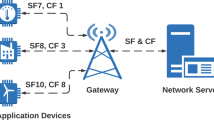Abstract
An internetwork of LANs is modeled as a graph with LAN segments as edges and transparent bridges and repeaters as nodes. The graph model leads to a simple expression for the effective load on an arbitrary LAN segment, which takes into account the overhead traffic due to the learning mechanism of the transparent bridges. Simplifying assumptions for the operation of the MAC layer protocol lead to a simple expression for the average end-to-end delay in terms of the effective loads on the LAN segments.
The problem of optimally locating bridges and repeaters on the nodes in order to minimize the average delay is then studied. It is shown that this problem is equivalent to the set partitioning problem, which is NP-complete, but for which good algorithms exist to solve large problems. The related problem of minimizing cost subject to a constraint on average end-to-end delay is also discussed. Finally, the problem of locating bridges and repeaters on a linear topology, as typically found in an office building with a large number of floors, is studied. This special case gives rise to anO(L 2) algorithm, whereL is the number of floors.
Similar content being viewed by others
References
F. Backes, Transparent bridges for interconection of IEEE 802 LANs, IEEE Network 2 (1988) 5–9.
E. Benhamou, Integerating bridges and routers in a large internetwork, IEEE Network 2 (1988) 65–71.
D. Bertsekas and R. Gallager,Data Networks (Prentice-Hall, Englewood Cliffs, NJ, 1987).
W. Bux, Local Area Networks: A performance comparison, IEEE Trans. Comm., COM-29 (1981) 1465–1473.
E.V. Denardo,Dynamic Programming: Models and Applications (Prentice-Hall, Englewood Cliffs, NJ, 1982).
M.L. Fisher and P. Kedia, Optimal solution of set covering/partitioning problems with dual heuristics, to appear in Manag. Sci. (1988).
M.R. Garey and D.S. Johnson,Computers and Intractability: A Guide to the Theory of NP-Completeness (Freeman, 1979).
M. Gondran and M. Minoux,Graphs and Algorithms (Wiley, Chichester, 1984).
S. Gupta, Performance modeling and optimization of interconnected Ethernets, Master's thesis, University of Pennsylvania, Dept. of Electrical Engineering (1989).
S.S. Lam, A carrier sense multiple access protocol for local networks, Computer Networks 4 (1980) 21–32.
M. Minoux, A class of combinatorial problems with polynomially solvable large scale set covering/partitioning relaxations, RAIRO Oper. Res. 21 (1988) 105–134.
G.L. Nemhauser and L.A. Wolsey,Integer and Combinatorial Optimization (Wiley, New York, 1988).
H. Salwen, R. Boule and J.N. Chiappa, Examination of the applicability of router and bridging techniques, IEEE Network 2 (1988) 77–80.
M. Schwartz,Telecommunication Networks: Protocols, Modeling and Analysis (Addison-Wesley, Reading, MA, 1987).
A.S. Tanenbaum,Computer Networks (Wiley, Chichester, 1988).
Author information
Authors and Affiliations
Additional information
Supported partially through AT&T grant 5-23690.
Rights and permissions
About this article
Cite this article
Gupta, S., Ross, K.W. Performance modeling and optimization of networks of bridged LANs. Queueing Syst 9, 113–132 (1991). https://doi.org/10.1007/BF01158794
Received:
Revised:
Issue Date:
DOI: https://doi.org/10.1007/BF01158794




